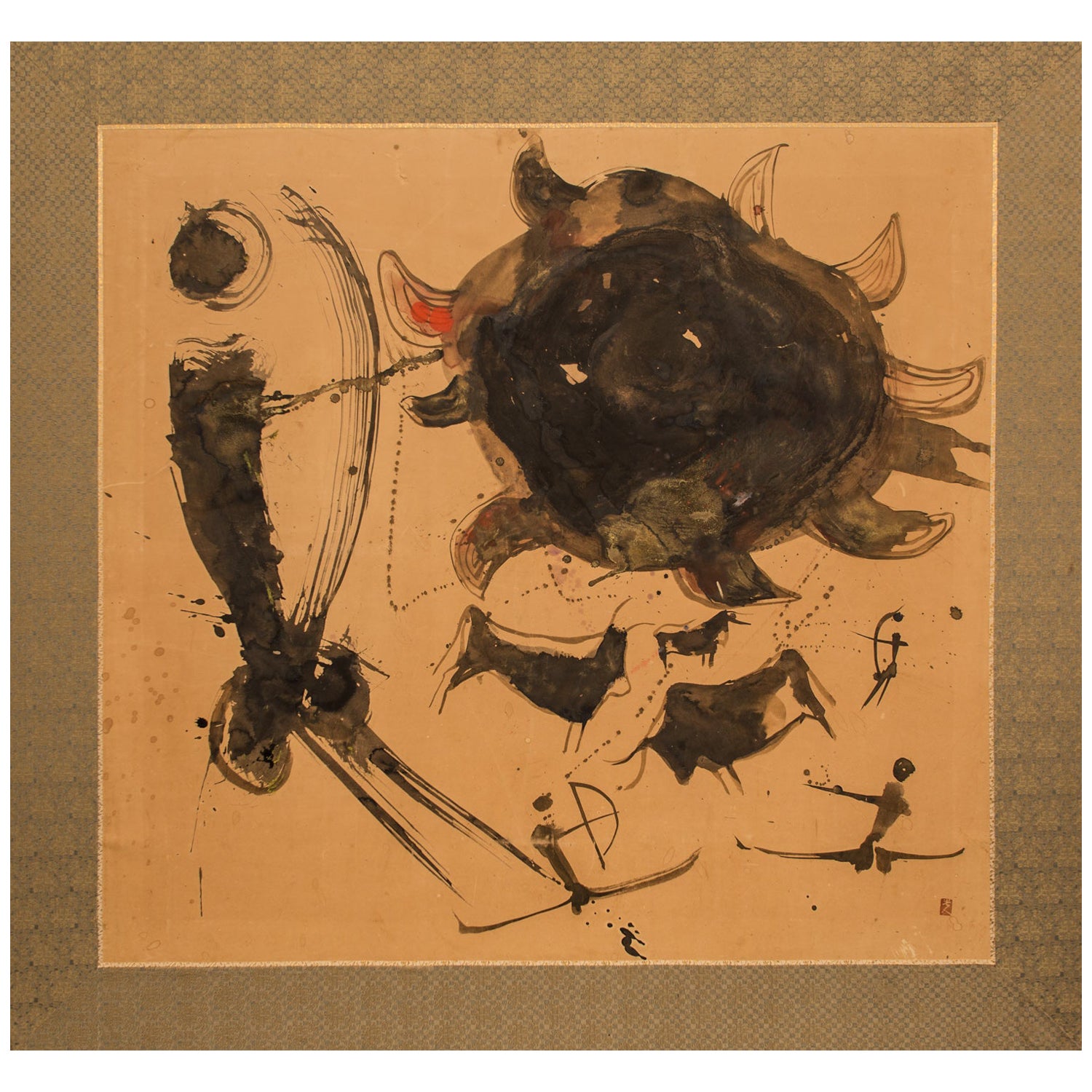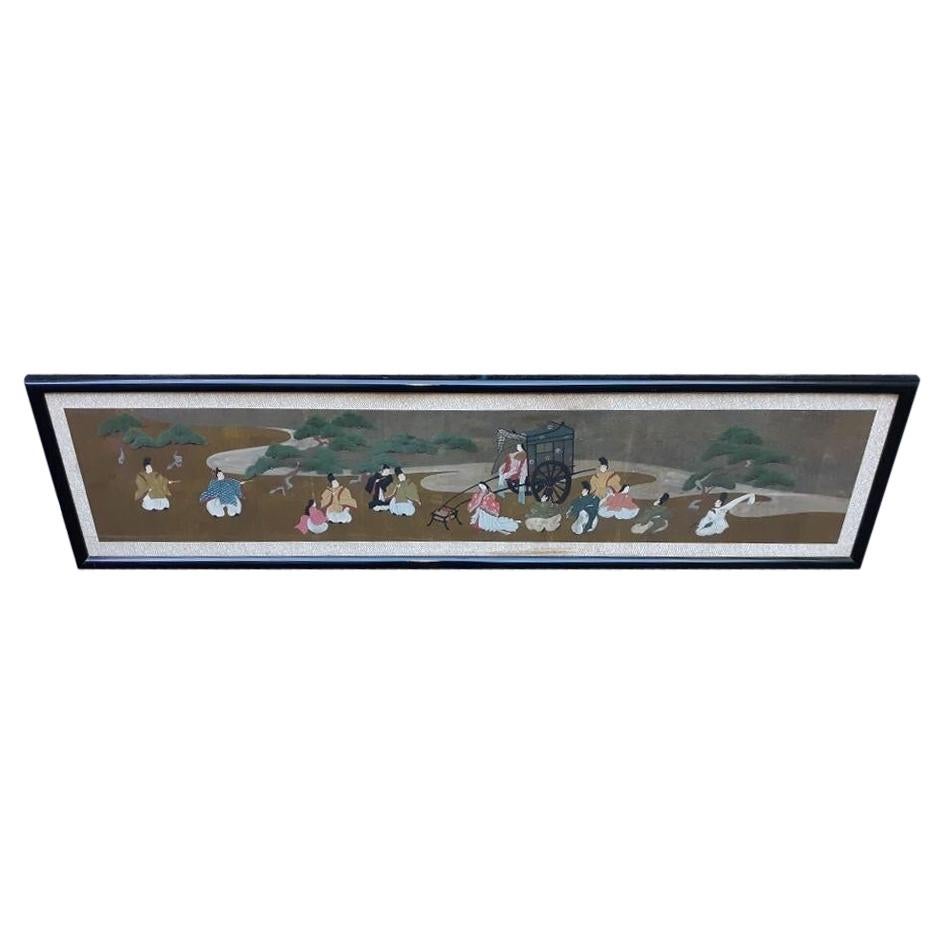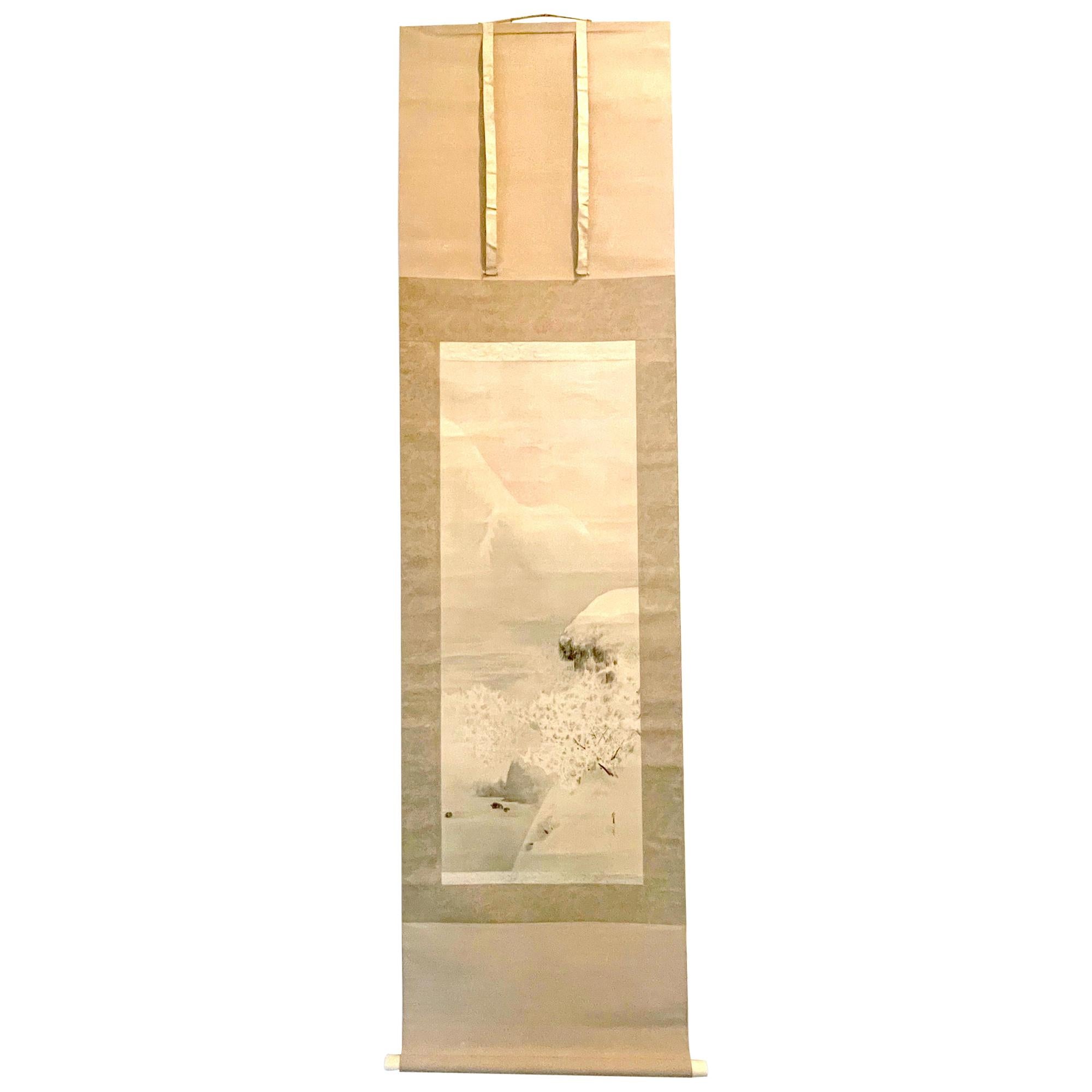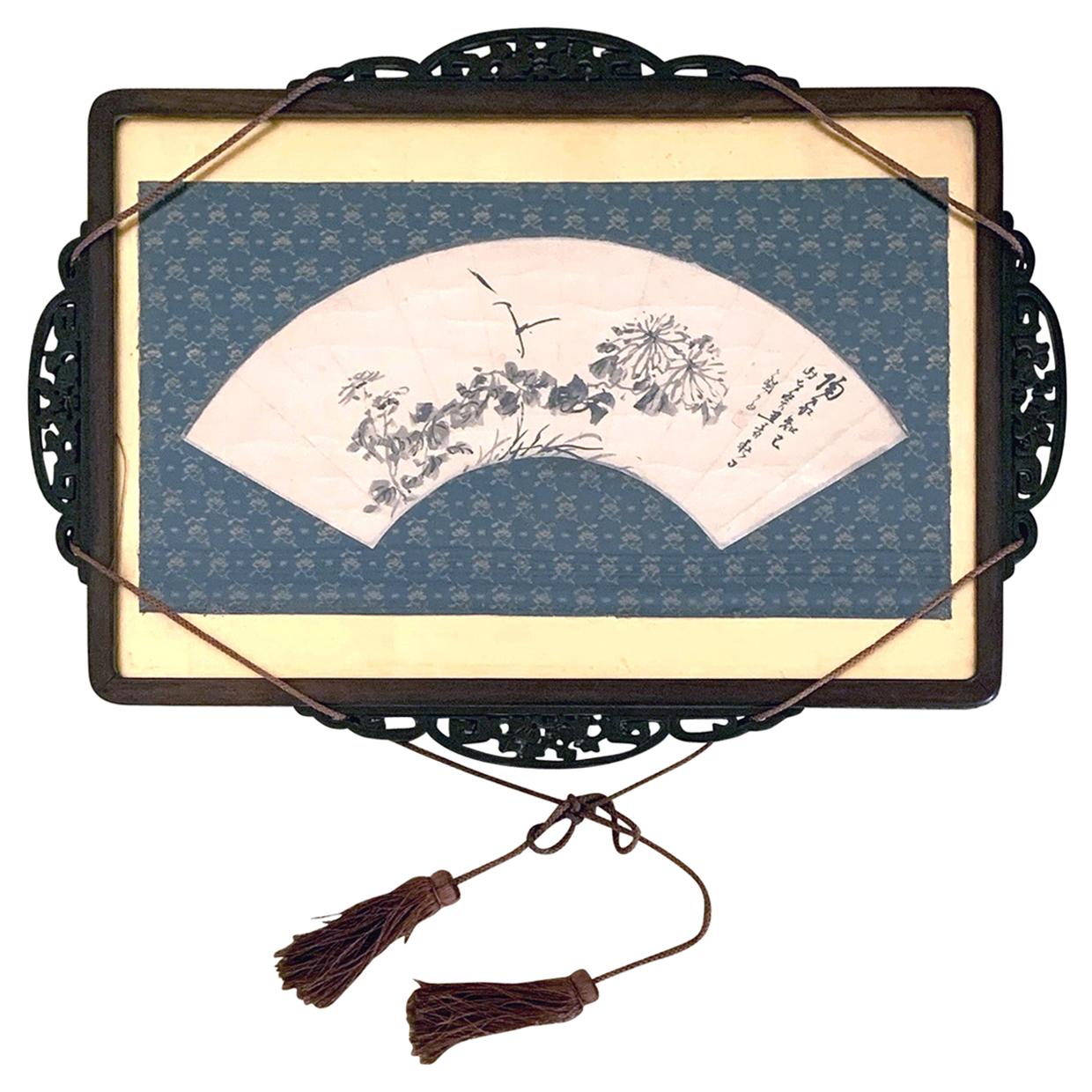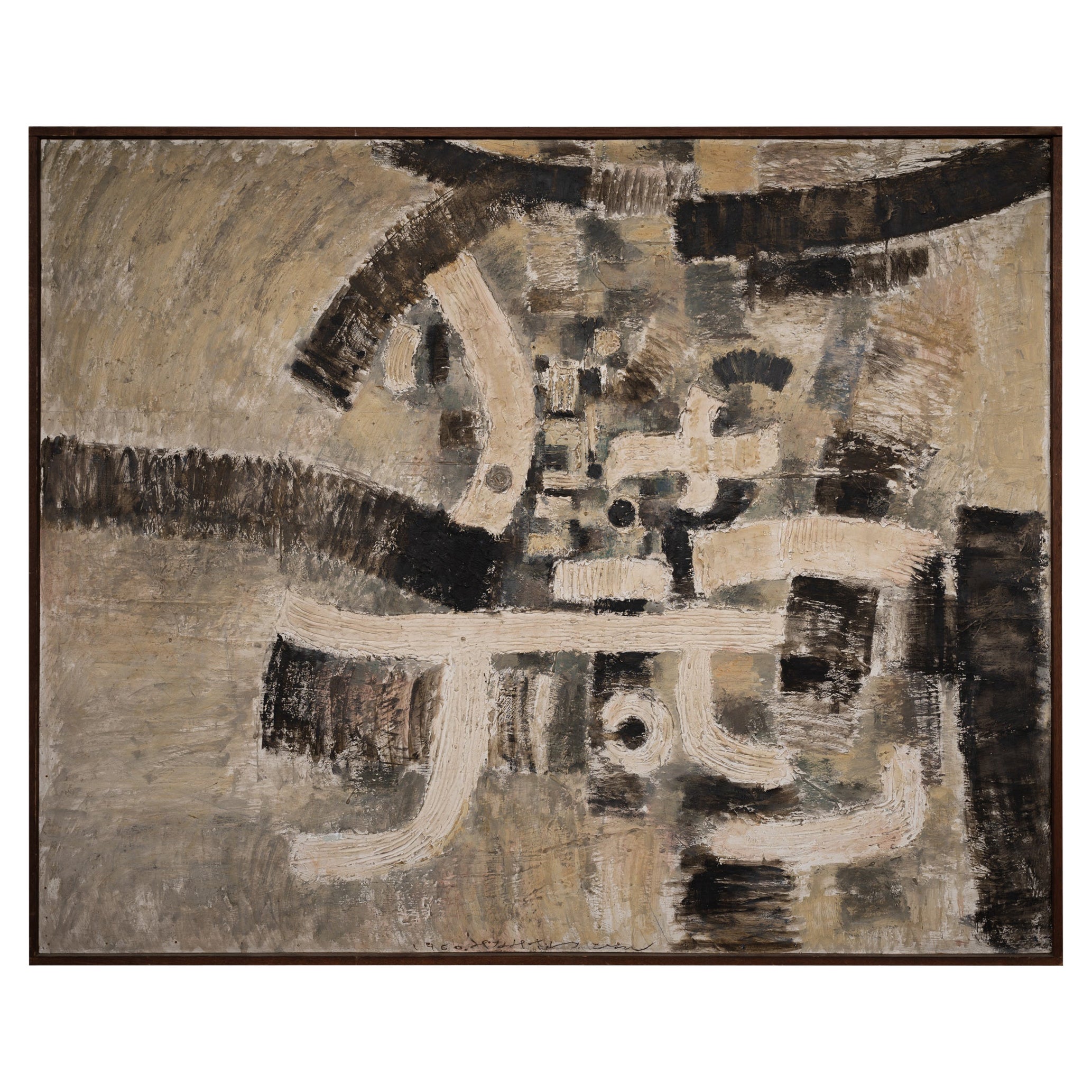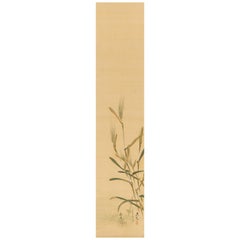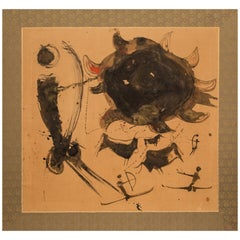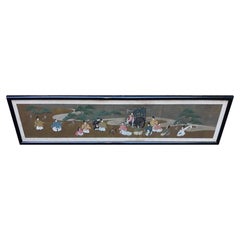Items Similar to Painting by Maeda Josaku (Japan, 1926 – 2007), Paysage Humain N° 14, 1960
Want more images or videos?
Request additional images or videos from the seller
1 of 8
Painting by Maeda Josaku (Japan, 1926 – 2007), Paysage Humain N° 14, 1960
About the Item
Signed: Josaku Meda. 60.
Singed on the back: "Paysage humain" N°14 / 7.1960 / Josaku MAEDA / à Paris
Exhibitions:
Turin (Italy), Gissi Gallery, Collettiva, 1960
Turin (Italy), Galatea Gallery, Josaku Maeda, 1960
Literature:
Luigi Carduccio, Josaku Maeda, Galatea Gallery ed, (Turin: 1960).
Born in Toyama prefecture in 1926, Josaku Maeda graduated at the Mushino Art University in 1953 and in 1957 he achieved the first prize at the International Young Artist Exhibition. This event represented for Maeda the first step toward an international artistic panorama: the following year the artist moves to Paris where he developed his studies and career. The European environment strongly influenced his early production, which is mainly influenced by the Informal and Abstract Expressionist art movements. In this period Maeda took part to important exhibitions on the worldwide scale, as the Biennale de Paris (1959) and the New Delhi Triennale in 1968. During the ’70s he spent long periods traveling to India, Tibet and South-East Asia, focusing his research on the mandala iconography and practice; this subject deeply influenced the overall artist's production, which shifted from abstract art to sacred painting, in conjunction with the publication of several books about mandala.
The red paint that characterizes Paysage Humain n° 14 is dramatically spread all over the smooth surface, gradually fading from a darker tone on the edges to more rarefied nuances of orange and yellow in the central area. Such concentric patterns, balanced between symmetry and imperfection, together with the flat background, represent an immediate reference to the Color Field art movement.
Labeled as Informal art, this canvas aims to be a complete rejection of the subject’s real forms, although the title ‘Human Landscape’ might suggest the idea of naturalistic painting. However, the Nature as the main source of inspiration connotes the all Maeda’s abstract artworks produced between 1959 and 1962, all of them presenting titles such as Halo du Soleil, Ombre et éclairé Celestes, Papillon de Nuit, Jardin des Delices.
- Dimensions:Height: 39.38 in (100 cm)Width: 25.6 in (65 cm)Depth: 0.79 in (2 cm)
- Materials and Techniques:Canvas,Oiled
- Place of Origin:
- Period:
- Date of Manufacture:1960
- Condition:
- Seller Location:Milano, IT
- Reference Number:Seller: 7471stDibs: LU4250212869402
About the Seller
5.0
Recognized Seller
These prestigious sellers are industry leaders and represent the highest echelon for item quality and design.
Established in 2005
1stDibs seller since 2018
10 sales on 1stDibs
Typical response time: 1 hour
- ShippingRetrieving quote...Ships From: Milano, Italy
- Return PolicyA return for this item may be initiated within 7 days of delivery.
Authenticity Guarantee
In the unlikely event there’s an issue with an item’s authenticity, contact us within 1 year for a full refund. DetailsMoney-Back Guarantee
If your item is not as described, is damaged in transit, or does not arrive, contact us within 7 days for a full refund. Details24-Hour Cancellation
You have a 24-hour grace period in which to reconsider your purchase, with no questions asked.Vetted Professional Sellers
Our world-class sellers must adhere to strict standards for service and quality, maintaining the integrity of our listings.Price-Match Guarantee
If you find that a seller listed the same item for a lower price elsewhere, we’ll match it.Trusted Global Delivery
Our best-in-class carrier network provides specialized shipping options worldwide, including custom delivery.More From This Seller
View AllHanging Scroll by Kamisaka Sekka, Japan
Located in Milano, IT
This painting represents a man waiting under a dark tree. The composition is extremely simple but suggestive. The artist, with few elements, can, in fact, create a vivid and dynamic scene, based on the tension between the strong ink stain that renders the tree and the elegant figure of the man, dressed in an aristocratic robe.
Painter and designer, Kamisaka Sekka...
Category
Early 20th Century Japanese Paintings and Screens
Materials
Paper
Shibata Zeshin ‘1807-1891’, Barley
Located in Milano, IT
Medium: Hanging scroll; ink and pigments on silk
Signature: Zeshin
Seal: Tairyukyo
Date: circa 1880
Painting size: 98 x 20 cm
Mounts size: 182 x 32 cm
Shibata Zeshin...
Category
Antique Mid-19th Century Japanese Paintings and Screens
Materials
Paper
Japanese Folding Screen with a Spring Landscape, Kano School, 19th Century
Located in Milano, IT
The scene is dominated by a plum tree in bloom under which a couple of paradise birds is courting. The screen is crossed by a luxuriant creek, a typical feature of the springtime.
Category
Antique 19th Century Japanese Paintings and Screens
Materials
Paper
Pair of Japanese Two-Fold Screens with Flower Arrangements and Rare Birds
Located in Milano, IT
Karamono with flower arrangements and rare birds
Edo period, 18th century
Pair of two-panel folding screens Ink, colors, gofun and gold leaf on paper
Each 170 by 165 cm
...
Category
Antique 18th Century Japanese Paintings and Screens
Materials
Paper
Japanese Two-Panel Screen with Scenes at the Pleasure Quarters, 18th Century
Located in Milano, IT
In the pleasure districts, the stringent codes were meant to be forgotten. In this painting, some clients are watching from outside the teahouse, while some are entering, one of them...
Category
Antique 18th Century Japanese Paintings and Screens
Materials
Paper
Pair of Japanese Screens with Flowers of the Four Seasons, 19th Century
Located in Milano, IT
This pair of screens belongs to a genre of lyrical paintings of flowers, grasses, and other plants that flourished around the middle of the 17th century and became a specialty of the Sôtatsu studio. The use of a rather complex composition of clusters of flowers and the puddling of ink was initiated by Tawaraya Sôtatsu, the founder of the Rimpa School, who was active from 1600 until 1642. The screens are abstract and decorative but there is, at the same time, a keen sense of naturalism not only in the attention to accurate detail but in the profusion of vegetation. The passage of the year is symbolized by the variety of plants that bloom in different seasons. The tarashikomi - here used on leaves, petals and trunks - is a Classic Rinpa technique in which pale black ink or a color is brushed onto an area of a painting and then either darker ink, or the same or a contrasting color, is dropped into the first before it has completely dried, creating an effect of pooled colors with softly blurred edges. Its delicacy, preciousness, and effeminacy are identified with the over-refinement of its patrons, while the vigor, monochromatic discipline, sharp observation, and virile forms of the Kano school are a testament to the vitality of the rising warrior class. The plants are almost all identifiable: in the summer-spring part, you can find wheat, buttercups, irises, begonias, hydrangeas, coral bells...
Category
Antique 19th Century Japanese Paintings and Screens
Materials
Paper
You May Also Like
Japanese Screen Painting, circa 1700 'Horses' by Kano Tanshin
Located in Kyoto, JP
Horses
Kano Tanshin Morimasa (1653-1718)
Two-panel tea-ceremony Japanese screen or furosaki
Ink on gold leaf,
late 17th-early 18th century
Measures: H 55 cm x W 182 cm
The Kano school was closely aligned with the warrior class in Japan. The samurai, who lived in a closed and rigid hierarchical society established by the Shogunate, were drawn to the energy and freedom horses symbolize; Kano school artists commonly depicted the equine creatures as they are here, in unfettered and carefree family groups. China originally introduced horse paintings to Japan; the works typically focused on capturing the essence of horses in their various environments and often involved integrating human figures into the images.
Kano Tanshin Morimasa (1653-1718) was the son of Kano Tanyu...
Category
Antique 1690s Japanese Edo Paintings and Screens
Materials
Gold Leaf
Japanese Modern Abstract Ink Painting
Located in Hudson, NY
On mulberry paper with silk brocade. From the estate of Andrea Bollt. Artist's seal reads: Mitsushito (died 1922).
Category
Antique Early 1900s Japanese Paintings and Screens
Materials
Brocade, Silk, Paper
Large Antique Horizontal Japanese Painting
Located in Lambertville, NJ
An antique horizontal Japanese Meiji period qouache watercolor painting with black lacquered frame under glass. 65.5 inches long, 17inches high. Th...
Category
Antique 1880s Japanese Meiji Paintings and Screens
Materials
Glass, Hardwood, Paper
Japanese Ink and Wash Scroll Painting by Watanabe Seitei
Located in Atlanta, GA
Watanabe Seitei, also known as Watanabe Shotei (1851–1918), was born in late Edo period. He was one of the earliest Japanese artists who visited and be...
Category
Antique Early 1900s Japanese Japonisme Paintings and Screens
Materials
Brocade, Silk, Paper
Framed Japanese Ink Painting Hidaka Tetsuo
By Hidaka Tetsuo
Located in Atlanta, GA
An ink painting on the fan surface by Japanese Zen artist Hidaka Tetsuo (1791-1871), now framed in a traditional Japanese carved wood frame with silk fabric mat and decorative hangin...
Category
Antique 1850s Japanese Japonisme Paintings and Screens
Materials
Wood, Paper
Japanese Single Panel Painting Formal Abstraction
Located in Hudson, NY
Acrylic and gouache on paper, mounted on board and framed, by Minamisawa Hiroshi. Bearing a label from the Avant-garde Kodo Art Group Exhibition 1955.
Category
Mid-20th Century Japanese Paintings and Screens
Materials
Acrylic, Paper
Recently Viewed
View AllMore Ways To Browse
Japanese 1960
Japanese Step
Japanese Labels
Long Japanese Screen
Painting Tibet
Art And Furniture Galleries In India
Red Japanese Screens
Japanese Painted Landscape Screen
Papillon Vintage
Vintage Celeste
Used Furniture Delhi
Mandala Tibet
Josaku Maeda
Large Asian Painting
Screen Japanese Screen
Japan Screen
Japanese Screens
Japan Silk

